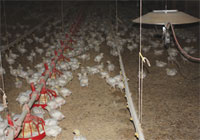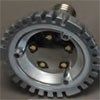



Poultry Lighting: LED Bulbs Provide Energy Savings and Durability
Tips on the best use of LED lighting for poultry from Professor Susan Watkins, Extension Poultry Specialist at the University of Arkansas.Lighting significantly impacts poultry production. Too little lighting during brooding or too much during grow–out can result in lost performance and profits. Solid side wall, tunnel–ventilated poultry barns are more energy efficient to operate but do require artificial lighting sources. The expense of lighting a poultry barn with 60–watt incandescent bulbs can be as much as 30 to 40 per cent of the electrical operating cost (US$100 to $250 per flock or barn, depending on barn size and flock age to market). Therefore, lighting improvements should not only be beneficial for the birds but also energy efficient to minimize production costs.
 |
|
 |
 |
| Examples of LED bulbs for poultry lighting Bulb photo credits: Luma Vue bulb (left), NextGen bulb (right) |
|
Compact fluorescent bulbs (CFL) are commonly used as replacements for incandescent lighting. While this source can save as much as 60 per cent of the lighting cost compared to incandescent bulbs, industry wide, CFL bulbs in poultry barns experience high failure rates due to bulb sensitivity to power fluctuations. A second common problem with CFL bulbs is dirt accumulation on the spirals which reduces bulb lumen light output, plus the bulbs naturally lose light output over time (lamp lumen depreciation, LLD). The bulbs also contain mercury, which is considered an environmental risk factor, so they require special disposal procedures. Cold cathode compact fluorescent bulbs (CCFL) are a second energy–efficient light source, but they are also sensitive to power fluctuations, contain mercury and lose light output over time.
LED, light–emitting diodes, have entered the market for poultry production in the last three years. LED technology involves light emitting from electrons, and this light source is now being used in broiler, turkey, layer and breeder production facilities with success. When brood lighting is adequate, bird performance with LED bulbs is proving to be as good as, if not better than, performance under traditional light sources. The LEDs are 80 to 85 per cent more efficient than incandescent bulbs, and the well–designed technologies have had no failures and are maintaining 70 to 80 per cent of their light output two years after installation in broiler barns. Since this technology is a growing field with new bulbs hitting the market at a rapid rate, poultry producers interested in LEDs should do their homework before purchasing. The following are key concepts to understand when selecting any bulb:
Has the bulb been tested or demonstrated in poultry barn environments?
- If yes, have results been released to the public?
- What was bird behaviour under the lights? A consistent observation by producers with LED bulbs is that the birds behave more calmly, even when the light level is raised from dim to full light. A possible reason is that LED light does not flicker compared to CFL bulbs, which can flicker at a level noticeable to the birds. Poultry have keen eyesight and are much more sensitive than humans to light flickering.
- Is there any information available regarding bulb efficiency and long–term lumen output or lamp lumen depreciation (LLD)? Do the bulbs have an Energy Star rating from third party testing? If applying for rebate programmes for LEDs, it is important to confirm if the Energy Star rating is required or if only certain types of lamps qualify.
- Have bulbs been cleaned under typical poultry barn wash–down procedures? Bulbs with an IP65 rating are actually rated for wash down.
What is the Kelvin (K) rating?
Kelvin refers to the colour temperature of the light.- 2,700-3,000K – Warm Kelvin, orange–red colour, e.g. incandescent bulb
- 3,400-3,700K – Neutral Kelvin, e.g. NextGen Ill. Poultry LED PL30
- 5,000-6,000K – Cool Kelvin, blue–white colour, e.g. Once Innovation Agrishift LED
What are bulb lumens?
Lumens are a measure of the total all–around light output. Bulbs like eight–watt cold cathodes with 325 lumens have very low light levels, whereas a 36–watt CFL could have 2,400 lumens, giving high light levels suitable for brooding. It is also important to understand that the lumen rating that new bulbs have is usually much higher than what some types of bulb technology emit after at least six months in operation in poultry facilities.How many foot–candles of light will my birds have?
Foot–candles of light at the bird level is a significant production tool to assure young birds start well and birds closer to market are minimising energy losses. Foot–candle is a measure of the light intensity on a surface and helps to standardise the value of light sources. A common standard for describing lights is lumens per watt (lm/W). The order of magnitudes is incandescent, 15lm/W; CFLs, 60lm/W and LEDs, 75lm/W.
Traditionally, newly hatched chicks have been given an average light intensity of at least two foot–candles for the first four to 14 days, depending on strain and dietary programme, with the majority of light focused over feed and water lines. Once birds have started well, then light intensity can be reduced.What is the light angle output?
The more restrictive the angle of the light output, the more shadows will appear between lights and at the wall. LEDs were first sold mainly as spotlights, and light output was limited to narrow circles, making these prototypes unsuitable for poultry production barns where grow lights may be located on 20–foot centres over feed lines.
The LED industry is now providing lights with a wider band of light output better suited to poultry production. It is recommended that the angle of light output should be a range of 120° to 160° to minimise dark areas in the barn. With incandescent bulbs, as much of the light went to ceilings and walls as it did to bird level. For LEDs with the light distribution less than 180°, light is now directed specifically toward the birds, hence reducing energy wastage on lighting unnecessary surfaces.How does the bulb get rid of heat?
When the diodes are on, heat is produced. While far less than the heat of an incandescent bulb, this heat must still be directed away from the diodes to prevent damage. There are at least two designs commonly used, fins or enlarged casing above the diodes. A third option is open slits to allow heat release. Openings for heat release can increase failure risk of bulbs in poultry barns because of diode exposure to the production environment.Are the bulbs compatible with dimmers and should they be dimmed similar to current lights used?
Unlike incandescent bulbs which dim in a linear fashion (meaning as the dimmer is turned down some percentage, the bulb output decreases the same percentage), most LED technology dims on a non–linear basis, i.e. the dimmer may need to be turned down significantly before a resulting dimming of the bulb occurs. New dimmers are being programmed to overcome this. However, producers need to be aware that existing dimmers and LEDs may not be 100 per cent compatible, and this may need to be addressed to assure uniform and proper dimming of lights.Is the electrical system properly designed for LED lights?
Unlike standard incandescent lamps, LED, CFL and cold cathode lamps are non–linear loads. Non–linear loads are loads where the current is not proportional to the voltage. It is not uncommon for lighting circuits to share a common neutral conductor in poultry houses. Neutral currents from linear incandescent lamps have a cancellation effect, so the use of common neutrals with incandescent lamp circuits makes sense. It can reduce wiring costs.
Neutral currents from the non–linear LED and CFL loads do not have a cancellation effect. In fact, the neutral currents can be additive. Be sure your neutral current is adequately sized when non–linear LED and CFL loads are installed on circuits using common neutrals. In new poultry house construction where non–linear loads will be utilised, common neutral conductors are not recommended. Check with a licensed electrician if there are concerns.
August 2012








